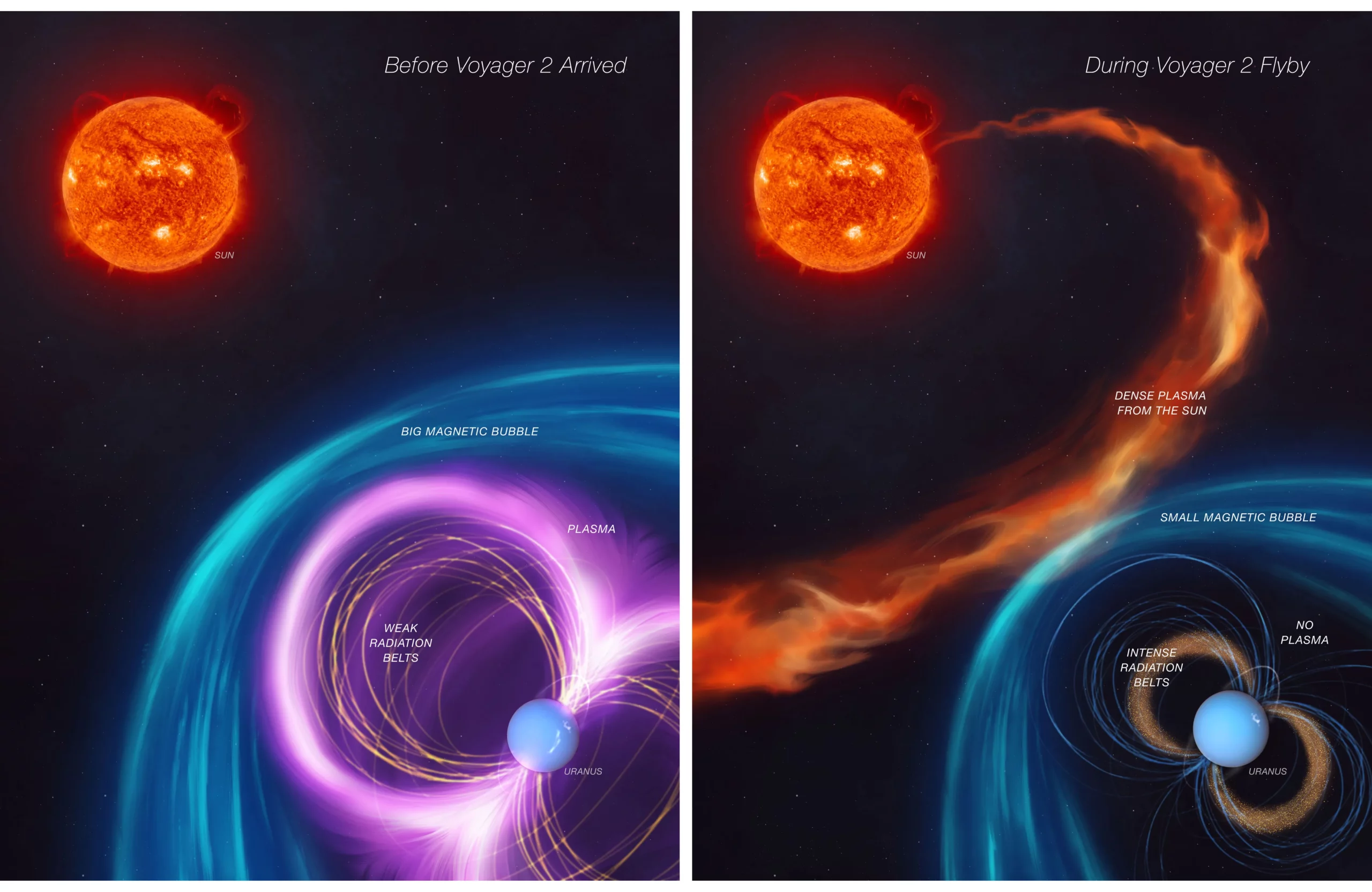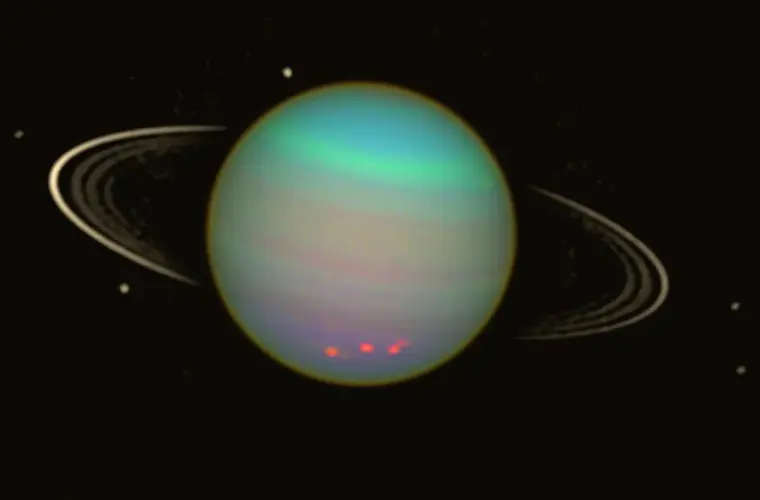In a twist worthy of an astronomical detective story, data from NASA’s Voyager 2, collected nearly 40 years ago, provides new insights that challenge our longstanding understanding of Uranus.
Scientists reanalyzing these aged datasets have uncovered compelling evidence suggesting our assumptions about the planet’s magnetosphere—a strange, off-kilter magnetic field—might have been based on a once-in-a-lifetime anomaly.
“If Voyager 2 had arrived just a few days earlier, it would have observed a completely different magnetosphere at Uranus,” Dr. Jamie Jasinski of NASA’s Jet Propulsion Laboratory (JPL) and lead study author said in a release. “The spacecraft saw Uranus in conditions that only occur about 4% of the time.”
Uranus has held a unique, almost enigmatic place in our understanding of the solar system. Since Voyager 2’s flyby in 1986, the scientific community has been working with a limited set of observations that shaped our knowledge of this icy planet.
But as scientists revisit these historic findings, using advanced analysis and data mining technology, a new narrative is emerging, one that may force scientists to rethink what they’ve assumed about Uranus.
During Voyager 2’s brief pass by Uranus, the probe documented an unexpectedly strong and unusual magnetic field. At the time, this oddity was considered a defining feature of the planet.
However, researchers now question whether Voyager’s data reflected Uranus’s normal state or if the probe’s timing coincided with rare conditions.
According to a new study published in Nature Astronomy, the Voyager 2 flyby may have caught Uranus during an extraordinary period of magnetic compression caused by high solar wind pressure, which researchers estimate occurs less than 5% of the time.
A magnetosphere is a powerful, protective shield surrounding planets with magnetic fields that guard them against the Sun’s solar wind—a stream of charged, ionized particles known as plasma.
This “bubble” deflects harmful solar particles, preserving a planet’s atmosphere and protecting its surface from intense radiation. Studying magnetospheres helps scientists understand how Earth’s magnetic shield works and reveals insights into the magnetic environments around distant, less-explored planets in our solar system and even beyond, shedding light on the forces shaping these planetary systems.
Uranus’s magnetosphere has long been an oddity. Unlike other planetary magnetic fields, which align more or less with their planet’s rotation, Uranus’s magnetic field is tilted at a sharp angle and displaced off-center. This causes Uranus’s magnetic field to behave differently from those of other planets in our solar system, producing what scientists describe as a “switch-like” magnetic cycle, where the magnetic field opens and closes to solar wind in a rhythm unique to this planet.
However, this new study, led by Dr. Jamie M. Jasinski from NASA’s Jet Propulsion Laboratory, suggests that Voyager 2’s brief encounter with Uranus captured the planet’s magnetic field during a compressed, anomalous state. This period of intense solar wind pressure pushed the magnetic boundary closer to the planet, altering the magnetic configuration in ways that may not be typical.
In fact, according to researchers, had Voyager 2 arrived just a few days earlier or later, the spacecraft might have recorded a vastly different magnetospheric configuration.
The intense solar wind conditions Voyager 2 encountered before reaching Uranus are central to this newfound mystery. Typically, Uranus experiences varied solar wind conditions over a roughly 27-day cycle, driven by the rotation of the Sun.
During the flyby, the planet was under unusually high solar wind pressure, which compressed its magnetosphere substantially. The study indicates that the pressure observed by Voyager 2 before crossing into Uranus’s magnetosphere was approximately 0.018 nPa (nano pascals), over 20 times higher than the expected baseline pressure.
These high-pressure conditions likely influenced multiple aspects of the planet’s magnetosphere, from its shape and boundary to the behavior of energetic particles within it.
For example, the high solar wind pressure could have contributed to Voyager 2’s detection of intense electron radiation belts and unusually low plasma densities in Uranus’s magnetosphere.
Such a scenario could temporarily alter the magnetosphere’s structure and lead to “empty” regions, which might explain why Voyager 2 recorded Uranus’s magnetosphere as almost void-like—a mystery that has puzzled scientists ever since.


(Image Source: NASA/JPL-Caltech))
Revisiting old data with new analytical techniques has emphasized the importance of timing in space exploration. While Voyager 2 offered the first—and still only—up-close glimpse of Uranus, the findings could be more unique than previously believed, capturing conditions that happen only a few times per century. This revelation underscores the challenges of drawing long-term conclusions about planetary atmospheres and magnetospheres based on fleeting observations.
Magnetic compressions like the one Voyager 2 witnessed are known to trigger dynamic processes across the solar system. When these compressions occur on Earth, they cause auroras and fluctuations in radiation belts. At Uranus, a similar compression event might generate intense radiation and temporarily drain plasma from the magnetosphere.
Comparisons with other planets, including Saturn and Earth, suggest that these compression events at Uranus may produce transient, high-energy environments that could have shaped the planet’s famously unusual magnetic structure.
These findings are a significant development for planetary science, emphasizing the necessity of long-term, detailed observations to gain an accurate picture of distant planets.
A single flyby, though groundbreaking, only tells part of the story. A dedicated orbiter mission to Uranus, as discussed in recent planetary mission proposals, could help fill in the gaps left by Voyager 2.
Such a mission could observe how Uranus’s magnetosphere behaves over an extended period, capturing its shifts and cycles in various conditions rather than relying on a single snapshot influenced by rare solar wind conditions. This would be particularly valuable given Uranus’s extreme axial tilt and unusual magnetic field, which create a dynamic environment with potential implications for understanding magnetic fields across the cosmos.
Moreover, a new mission could investigate whether Uranus’s major moons, such as Titania and Oberon, might host subsurface oceans. The study notes that these moons periodically cross into and out of Uranus’s magnetosphere, which could expose them to varying levels of solar wind and plasma.
Detecting magnetic induction signals on these moons, influenced by this magnetospheric variability, could hint at the presence of conductive oceans beneath their icy crusts—a tantalizing prospect for astrobiology.
This reinterpretation of Voyager 2’s findings does more than add nuance to our view of Uranus—it reminds us that even well-accepted scientific conclusions should be revisited as new tools and perspectives emerge.
Uranus, often viewed as the “quiet” or “static” ice giant compared to its stormier counterpart Neptune, may be more volatile and complex than imagined.
These latest insights set the stage for Uranus to shed its reputation as an enigmatic outlier and take on a new identity as a celestial body with dynamic forces at play. And as scientists continue mining the Voyager 2 archive, the past might hold even more surprises for the future of planetary exploration.
With this new discovery from Voyager 2’s legacy data, the case for a dedicated mission to Uranus grows stronger. The icy giant has quietly held secrets in its magnetic and atmospheric patterns that a single flyby, however historic, couldn’t fully unlock.
In the decades since Voyager 2, technology has advanced, and so has our understanding of what’s required to peel back the layers of a planet shrouded in mystery. Perhaps, as we aim to return to Uranus in the not-so-distant future, we’ll find that the secrets Voyager 2 glimpsed were just the beginning of a story waiting to be told.
“The flyby was packed with surprises, and we were searching for an explanation of its unusual behavior. The magnetosphere Voyager 2 measured was only a snapshot in time,” Dr. Linda Spilker, a planetary scientist at JPL who worked on the initial 1986 Voyager missions, noted. “This new work explains some of the apparent contradictions, and it will change our view of Uranus once again.”
Tim McMillan is a retired law enforcement executive, investigative reporter and co-founder of The Debrief. His writing typically focuses on defense, national security, the Intelligence Community and topics related to psychology. You can follow Tim on Twitter: @LtTimMcMillan. Tim can be reached by email: tim@thedebrief.org or through encrypted email: LtTimMcMillan@protonmail.com

